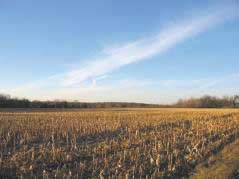|
Utilizing Cornstalks Despite Wet Weather
URBANA, ILL.
Wet, rainy weather conditions are beginning to cause headaches for farmers. Besides the obvious delay in harvest, additional moisture is negatively affecting grain and cornstalk quality for cattle producers that normally utilize the crop residue to extend the grazing season, according to a University of Illinois Extension beef educator.
Excess rain causes leaching of nutrients available in cornstalks, Travis Meteer explained. It also decreases palatability of the crop residue. Lower intakes of a less nutritious feed will result in poorer animal performance.
According to Meteer, grazing cornstalks is still a valuable tool for cattlemen looking to hold costs in place. The cost of grazing cornstalks is low first because the cows graze and harvest their own feed, and second, because all costs of producing the plant for grain production are attributed to the row-crop operation, he explained. “Even with the cost of a temporary fence – which many farmers already have – and water, the use of grazing cornstalks is more economical than feeding higher-priced hay.”
Meteer also explained that even with lower palatability due to wet, damp stalks, cattle will eat the more digestible and higher-protein portions first. “Therefore, a good mineral is probably the only supplementation needed for the first few weeks unless the herd includes fall-calving cows or stocker calves,” Meteer advised. “For them, a supplement will be necessary to meet nutrient demands of lactation and growth, respectively.”
Normally, one acre of cornstalks is needed to feed a cow for 30 days. If wet, rainy conditions persist, at least two to three acres will be needed due to faster degradation and more trampling of the residue. Strip grazing will limit trampling if the supply of available cornstalks is low.

Meteer said producers need to scout fields for several things. “First, look for ear drop and down corn areas. A significant amount of grain loss in fields can cause acidosis or founder in animals,” he said. “Fields with these areas will need careful management via strip grazing or completely fencing the problem areas out.
“Second, look for molds on remaining ears of corn. Some reports of Diplodia have been surfacing which will not cause major problems if ingested by cattle, but Diplodia will open the grain up to other fungus such as Fusarium and Gibberella. These molds can produce mycotoxins, including fumonisin, deoxynivalenol (DON or vomitoxin), and zearalenone,” he added.
Because cattle select the grain portion first when grazing, Meteer explained that toxic levels can be ingested if low to moderate levels of mycotoxin are present. “Because accurately sampling residue can be challenging, it is recommended to use mycotoxin levels in the grain to determine risk. If the grain contains less than 1 ppm of DON (vomitoxin) or less than 3 ppm of fumonisin or zearelenone, the cornstalks are likely safe to graze and the risk is very low,” he said.
Meteer pointed out that baling cornstalks in a wet fall can pose many challenges. “Obviously, wet cornstalks do not keep well in a bale. They are subject to mold, heating, and large amounts of spoilage. Cornstalks that have been rained on will also have higher levels of soil contamination, which will increase ash levels in the nutrient analysis of the baled forage. Soil contamination will decrease the nutritive value of the already poorer-quality feed,” he said.
For producers asking if compaction issues surface after grazing cornstalks, Meteer pointed out that research conducted at the U of I’s Dudley Smith Research Farm shows that compaction from grazing cattle does not even approach agronomic effect. “In these trials, cattle are removed in early winter to be provided a diet that better meets nutrient requirements. Cattlemen and landowners should not worry about compaction as long as cattle are stocked appropriately and removed in a timely manner,” he said.
All in all, Meteer said the wet weather is causing the quality of cornstalks to decline. “Producers need to increase acreage available compared to last year to accommodate a similar number of cows. Scouting fields is a must. Looking for ear drop and ear molds will be necessary to mitigate risk. Some supplementation may be needed if cows are required to graze cornstalks longer than 30 days. Cattlemen should still take advantage of grazing crop residues; however, more management may be needed in comparison to a normal, dry-weather fall,” he said. ∆
|
|